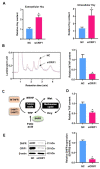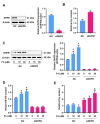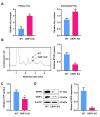CRIF1 Deficiency Increased Homocysteine Production by Disrupting Dihydrofolate Reductase Expression in Vascular Endothelial Cells
- PMID: 34829516
- PMCID: PMC8614757
- DOI: 10.3390/antiox10111645
CRIF1 Deficiency Increased Homocysteine Production by Disrupting Dihydrofolate Reductase Expression in Vascular Endothelial Cells
Abstract
Elevated plasma homocysteine levels can induce vascular endothelial dysfunction; however, the mechanisms regulating homocysteine metabolism in impaired endothelial cells are currently unclear. In this study, we deleted the essential mitoribosomal gene CR6 interacting factor 1 (CRIF1) in human umbilical vein endothelial cells (HUVECs) and mice to induce endothelial cell dysfunction; then, we monitored homocysteine accumulation. We found that CRIF1 downregulation caused significant increases in intracellular and plasma concentrations of homocysteine, which were associated with decreased levels of folate cycle intermediates such as 5-methyltetrahydrofolate (MTHF) and tetrahydrofolate (THF). Moreover, dihydrofolate reductase (DHFR), a key enzyme in folate-mediated metabolism, exhibited impaired activity and decreased protein expression in CRIF1 knockdown endothelial cells. Supplementation with folic acid did not restore DHFR expression levels or MTHF and homocysteine concentrations in endothelial cells with a CRIF1 deletion or DHFR knockdown. However, the overexpression of DHFR in CRIF1 knockdown endothelial cells resulted in decreased accumulation of homocysteine. Taken together, our findings suggest that CRIF1-deleted endothelial cells accumulated more homocysteine, compared with control cells; this was primarily mediated by the disruption of DHFR expression.
Keywords: CR6 interacting factor 1; dihydrofolate reductase; folic acid; homocysteine.
Conflict of interest statement
The authors declare no conflict of interest.
Figures






Similar articles
-
Multifunctions of CRIF1 in cancers and mitochondrial dysfunction.Front Oncol. 2022 Oct 3;12:1009948. doi: 10.3389/fonc.2022.1009948. eCollection 2022. Front Oncol. 2022. PMID: 36263222 Free PMC article. Review.
-
CR6-Interacting Factor 1 Deficiency Impairs Vascular Function by Inhibiting the Sirt1-Endothelial Nitric Oxide Synthase Pathway.Antioxid Redox Signal. 2017 Aug 1;27(4):234-249. doi: 10.1089/ars.2016.6719. Epub 2017 May 24. Antioxid Redox Signal. 2017. PMID: 28117598
-
CR6-interacting factor 1 deficiency reduces endothelial nitric oxide synthase activity by inhibiting biosynthesis of tetrahydrobiopterin.Sci Rep. 2020 Jan 21;10(1):842. doi: 10.1038/s41598-020-57673-9. Sci Rep. 2020. PMID: 31964986 Free PMC article.
-
CR6 interacting factor 1 deficiency promotes endothelial inflammation by SIRT1 downregulation.PLoS One. 2018 Feb 23;13(2):e0192693. doi: 10.1371/journal.pone.0192693. eCollection 2018. PLoS One. 2018. PMID: 29474366 Free PMC article.
-
Folate, homocysteine, endothelial function and cardiovascular disease.J Nutr Biochem. 2004 Feb;15(2):64-79. doi: 10.1016/j.jnutbio.2003.08.010. J Nutr Biochem. 2004. PMID: 14972346 Review.
Cited by
-
Cardiovascular aging: spotlight on mitochondria.Am J Physiol Heart Circ Physiol. 2024 Feb 1;326(2):H317-H333. doi: 10.1152/ajpheart.00632.2023. Epub 2023 Dec 1. Am J Physiol Heart Circ Physiol. 2024. PMID: 38038719 Free PMC article. Review.
-
Oxidative Stress in Cardiovascular Disease and Comorbidities.Antioxidants (Basel). 2022 Aug 3;11(8):1519. doi: 10.3390/antiox11081519. Antioxidants (Basel). 2022. PMID: 36009237 Free PMC article.
-
Multifunctions of CRIF1 in cancers and mitochondrial dysfunction.Front Oncol. 2022 Oct 3;12:1009948. doi: 10.3389/fonc.2022.1009948. eCollection 2022. Front Oncol. 2022. PMID: 36263222 Free PMC article. Review.
-
Mapping the future: bibliometric insights into ferroptosis and diabetic nephropathy.Front Physiol. 2025 Apr 10;16:1516466. doi: 10.3389/fphys.2025.1516466. eCollection 2025. Front Physiol. 2025. PMID: 40276370 Free PMC article. Review.
References
-
- Graham I.M., Daly L.E., Refsum H.M., Robinson K., Brattstrom L.E., Ueland P.M., Palma-Reis R.J., Boers G.H., Sheahan R.G., Israelsson B., et al. Plasma homocysteine as a risk factor for vascular disease. The European Concerted Action Project. JAMA. 1997;277:1775–1781. doi: 10.1001/jama.1997.03540460039030. - DOI - PubMed
Grants and funding
LinkOut - more resources
Full Text Sources

